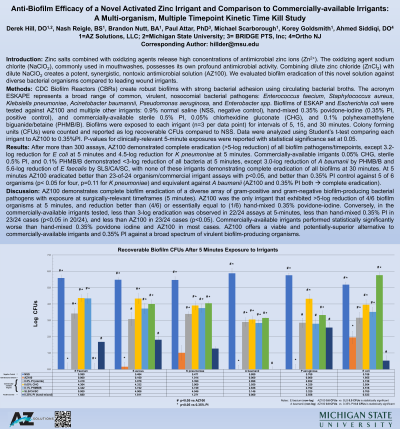Laboratory Research
(LR-021) Anti-Biofilm Efficacy of a Novel Activated Zinc Irrigant and Comparison to Commercially-Available Irrigants: A Multiple Organism, Multiple Timepoint, Kinetic Time-Kill Study
Friday, April 28, 2023
7:15 PM - 8:30 PM East Coast USA Time

Nash Reigle, BS; Nutt Brandon, BA; Attar Paul, PhD, MBA; Michael Scarborough, N/A; Korey Goldsmith, N/A; Ahmed Siddiqi, DO
Introduction: Zinc salts combined with oxidizing agents release high concentrations of antimicrobial zinc ions (Zn2+). The oxidizing agent sodium chlorite (NaClO2), commonly used in mouthwashes, possesses its own profound antimicrobial activity. Combining dilute zinc chloride (ZnCl2) with dilute NaClO2 creates a potent, synergistic, nontoxic antimicrobial solution (AZ100). We evaluated biofilm eradication of this novel solution against diverse bacterial organisms compared to leading wound irrigants.
Methods: CDC Biofilm Reactors (CBRs) create robust biofilms with strong bacterial adhesion using circulating bacterial broths. The acronym ESKAPE represents a broad range of common, virulent nosocomial bacterial pathogens: Enterococcus faecium, Staphylococcus aureus, Klebsiella pneumoniae, Acinetobacter baumannii, Pseudomonas aeruginosa, and Enterobacter spp. Biofilms of ESKAP and Escherichia coli were tested against AZ100 and multiple other irrigants: 0.9% normal saline (NSS/negative control), hand-mixed 0.35% povidone-iodine (0.35%PI/positive control), and commercially-available sterile 0.5% PI, 0.05% chlorhexidine gluconate (CHG), and 0.1% polyhexamethylene biguanide/betaine (PHMB/B). Biofilms were exposed to each irrigant (n=3 per data point) for intervals of 5/15/30 minutes. Colony forming units (CFUs) were counted and reported as log-reductions of CFUs compared to NSS. Data were analyzed using Student’s t-test comparing each irrigant to AZ100 to 0.35%PI. P-values were reported with statistical significance set at 0.05.
Results: After more than 300 assays, AZ100 demonstrated complete eradication ( >4-log reduction) of all biofilm pathogens/timepoints. Commercially-available irrigants 0.05% CHG, sterile 0.5% PI, and 0.1% PHMB/B demonstrated < 3-log reduction of all bacteria at 5 minutes, with none of these irrigants demonstrating complete eradication of all biofilms at 30 minutes. At 5 minutes AZ100 eradicated better than all commercial irrigants (p< 0.05) for all organisms, and better than 0.35% PI control against 5 of 6 of these (p< 0.05 for four, p=0.09 for S. aureus) and equivalent against A. baumanii (AZ100 and 0.35% PI both=complete eradication).
Discussion: AZ100 demonstrates complete biofilm eradication of a diverse array of gram-positive and gram-negative biofilm-producing bacterial pathogens with exposure at surgically-relevant timeframes (5 minutes). AZ100 was the only irrigant that exhibited >4-log reduction of all biofilm organisms at 5 minutes, and reduction better than (5/6) or equal to (1/6) hand-mixed 0.35% povidone-iodine. Conversely, the commercially-available irrigants tested all achieved less than 3-log eradication at 5-minutes against all organisms, less than hand-mixed 0.35% PI in 17/18 cases (p< 0.05 in 13/18), and less than AZ100 in all cases (p< 0.05 in 17/18). AZ100 offers a viable and potentially-superior alternative to commercially-available irrigants and 0.35% PI against virulent biofilm organisms.
Methods: CDC Biofilm Reactors (CBRs) create robust biofilms with strong bacterial adhesion using circulating bacterial broths. The acronym ESKAPE represents a broad range of common, virulent nosocomial bacterial pathogens: Enterococcus faecium, Staphylococcus aureus, Klebsiella pneumoniae, Acinetobacter baumannii, Pseudomonas aeruginosa, and Enterobacter spp. Biofilms of ESKAP and Escherichia coli were tested against AZ100 and multiple other irrigants: 0.9% normal saline (NSS/negative control), hand-mixed 0.35% povidone-iodine (0.35%PI/positive control), and commercially-available sterile 0.5% PI, 0.05% chlorhexidine gluconate (CHG), and 0.1% polyhexamethylene biguanide/betaine (PHMB/B). Biofilms were exposed to each irrigant (n=3 per data point) for intervals of 5/15/30 minutes. Colony forming units (CFUs) were counted and reported as log-reductions of CFUs compared to NSS. Data were analyzed using Student’s t-test comparing each irrigant to AZ100 to 0.35%PI. P-values were reported with statistical significance set at 0.05.
Results: After more than 300 assays, AZ100 demonstrated complete eradication ( >4-log reduction) of all biofilm pathogens/timepoints. Commercially-available irrigants 0.05% CHG, sterile 0.5% PI, and 0.1% PHMB/B demonstrated < 3-log reduction of all bacteria at 5 minutes, with none of these irrigants demonstrating complete eradication of all biofilms at 30 minutes. At 5 minutes AZ100 eradicated better than all commercial irrigants (p< 0.05) for all organisms, and better than 0.35% PI control against 5 of 6 of these (p< 0.05 for four, p=0.09 for S. aureus) and equivalent against A. baumanii (AZ100 and 0.35% PI both=complete eradication).
Discussion: AZ100 demonstrates complete biofilm eradication of a diverse array of gram-positive and gram-negative biofilm-producing bacterial pathogens with exposure at surgically-relevant timeframes (5 minutes). AZ100 was the only irrigant that exhibited >4-log reduction of all biofilm organisms at 5 minutes, and reduction better than (5/6) or equal to (1/6) hand-mixed 0.35% povidone-iodine. Conversely, the commercially-available irrigants tested all achieved less than 3-log eradication at 5-minutes against all organisms, less than hand-mixed 0.35% PI in 17/18 cases (p< 0.05 in 13/18), and less than AZ100 in all cases (p< 0.05 in 17/18). AZ100 offers a viable and potentially-superior alternative to commercially-available irrigants and 0.35% PI against virulent biofilm organisms.

.png)